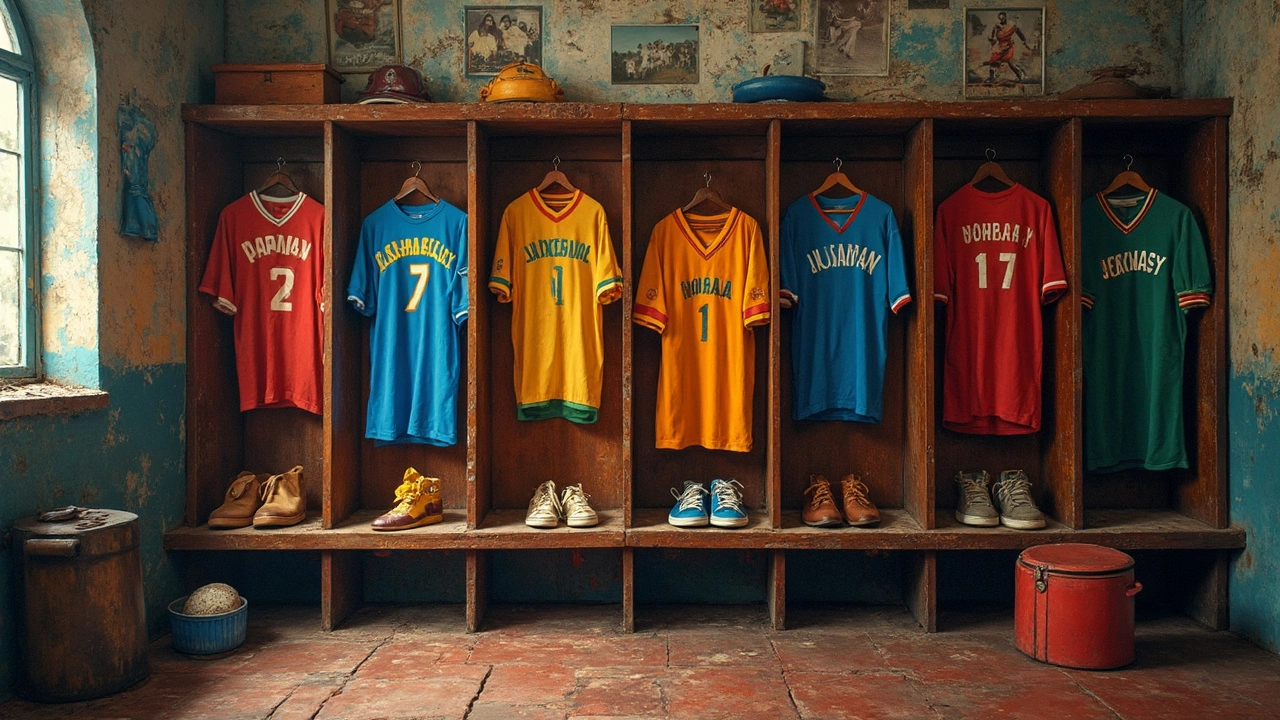Picture this: it’s Saturday, and the biggest rivalry of the year is about to go down. You turn on the TV, and you spot two teams facing off. But how do you know instantly which squad is defending home turf? It’s not just the crowd or the stadium. It’s those uniforms—the colors that let you pick out your crew at a single glance. And when it comes to away uniforms, there’s a whole story hiding in those shades. Turns out, the history of what color away uniforms are isn’t just a fashion choice. There’s logic, tradition, and more quirks than you might imagine behind those fabric decisions.
The Origins of Away Uniform Colors: Why Not Just Wear Anything?
Let’s rewind to when teams used to wear whatever they wanted. It was chaos. In the late 1800s and early 1900s, most teams in sports like baseball, American football, and soccer didn’t actually care much about uniform consistency. You might see patterns, stripes, solids, even some homemade stuff sewn by players’ moms. But as leagues formed and rivalries got heated, something had to give—especially when teams showed up in nearly identical kits, prompting both confusion on the field and brawls among fans.
So leagues began to set some rules. Baseball, one of America’s favorite pastimes, got serious in the early 1900s. Major League Baseball outlined that home teams should wear whites and away teams should pick darker colors, often grays. Why? White was easier to keep clean at home, where you had laundry access. But out on the road, visiting teams didn’t have that luxury; darker colors hid those inevitable stains from muddy slides and dusty fields. That little bit of practicality kicked off a tradition you still see everywhere, from youth leagues to the World Series.
Jump over to the world of soccer (football for folks outside the US), and the approach shifted slightly. Clubs traditionally played home games in their main colors as a symbol of pride. When conflicts cropped up, the visiting team would swap into an alternate kit—often nicknamed a “change strip” or “away kit.” The main rule? Make sure you stand out from the home team and the referees. FIFA and other governing bodies now demand away colors be clearly distinguishable, and referees have the final say if there’s a clash.
American football tossed its own spin in during the 1950s. The NFL decreed that one team (usually the home side) must wear a light jersey and the other a dark one. Most teams now opt for white or very light away uniforms. Think about the Dallas Cowboys, rocking their iconic road whites, or the Green Bay Packers, always flipping to white when traveling. Overnight, the color of away uniforms became part of the team’s identity, not just a practical fix.
Famous Away Uniform Colors and Their Meanings
It’s funny how a simple color swap can mess with your brain—or spark a heated debate among fans. Ask a longtime hockey fan about the classic red Montreal Canadiens away jersey, or a soccer supporter about Liverpool’s bold colors, and you’ll unleash a mountain of opinions. Let’s dive into a few famous examples across major sports and see what makes their away uniforms stand out—and why some teams stick to tradition while others mix it up.
In baseball, gray still rules for away games. If you watch the New York Yankees, you’ll spot them in clean pinstripes at home and simple gray on the road. Some say it’s boring, but it’s as classic as a hot dog in the bleachers. The St. Louis Cardinals, Detroit Tigers, and Boston Red Sox also roll out understated gray road uniforms that haven’t budged much since the early 20th century. These grays are more than just a color: they connect generations of die-hards and make road wins feel like a little rebellion against baseball’s old-guard traditions.
Soccer clubs run wild with away kits. Arsenal’s yellow and blue away jerseys, Real Madrid’s odd neon green alternates, and Juventus’ electric pink away shirt from a few years ago prove that anything goes. In Europe, away kits are where designers break free from the home crowd’s traditions. They often get wild, futuristic, or even a bit, well, questionable. But there’s always a reason—whether it’s paying tribute to a city’s history or making sure you’re never mistaken for the opposition. Sometimes, away kits even outsell the regular ones because they look unique and fans want something to show their individual style.
American football’s NFL sticks closer to tradition. Most teams play away games in white or super light hues. The Miami Dolphins, for instance, wear a shockingly bright aqua at home and flip to a sharp, bright white on the road. The Chicago Bears have navy for home, white for away; the New England Patriots flash bright silver pants with a crisp white jersey away. These choices aren’t random—in fact, NFL teams often flip who wears light or dark at home for tactical or weather reasons. And yes, the infamous 2007 Buffalo Bills went deep blue-on-blue for away, almost breaking the internet among fans horrified by the lack of contrast.
Hockey, ever the rebel, flipped the script in 2003. The NHL made home teams wear dark and away teams wear white, the opposite of most American sports. It started as a way to show off colorful home jerseys, but now, fans actually argue if white looks better on the road or if vibrant shades stand out more for visiting crowds.

Why Do Some Teams Break the Mold? Uniform Drama and Rule-Bending
Rules are one thing. But leave it to sports teams to find creative loopholes—or just toss out the playbook when it comes to away uniforms. Some of the most memorable games in history happened because of a “kit clash” or a league bending the rules for a special occasion.
Let’s talk about college football. Here, traditions are sacred, but bigger schools love a bit of flair. The LSU Tigers famously wear white at home, defying the usual home-dark trend. In rivalry games like Alabama vs. LSU, arguments about who gets to wear white or home colors can stretch back decades. At bowl games with no true “home,” coin tosses sometimes decide what team gets their preferred kit.
Soccer is even more notorious for wacky uniform situations. FA Cup finals and Champions League knockout matches have seen teams changing into third or even fourth kits because all other options matched the opposition. Remember when Chelsea ended up in yellow after both their blue kit and white away clashed with Liverpool’s red? Sometimes kit suppliers even rush-print new jerseys days before a match to solve last-minute color problems. FIFA now lets teams submit up to three or four color options before international tournaments, just to be safe.
Occasionally, teams wear special edition away kits for one-off events. The NBA goes all-out during its “City Edition” jersey weeks, where teams rock colors that draw on local culture or quirky historical references. The Miami Heat have sported neon pink and blue, while the Brooklyn Nets throw it back with graffiti-styled away gear. While these break with tradition, fans gobble them up—and it’s a handy excuse for teams to sell one more piece of merch.
So, rules exist to keep colors obvious, but exceptions and creative tweaks let teams show personality. If you spot a squad wearing something outlandish away from home, odds are there’s a story: a nod to history, an unlucky losing streak (yep, superstition counts!), or just a marketing stunt that paid off.
Tips for Recognizing and Understanding Away Uniform Colors
Okay, next time you find yourself squinting at a screen, wondering who’s who out there, use these tips to crack the code on away uniforms. First, check the color: classic gray in baseball, bright white in American football, and something bolder or unusual in soccer and basketball are dead giveaways. If you’re at a game, listen for the crowd’s reaction—a big cheer from the visiting section often means their squad just took the field in an away kit.
But uniforms do more than just look sharp. Sometimes, they reflect deeper stories—like racial integration, military tributes, or city traditions. Those throwback “powder blue” MLB road uniforms? They honor teams’ past eras and stand out in highlight reels. Before the era of high-def broadcasts, teams even chose uniform colors with TV clarity in mind—nothing worse than two teams blending together on black-and-white screens back in the day.
These days, teams announce new away uniforms online before the season. Social media blows up with fan takes—and, more often than not, divided opinions about the look. Want to get a sense of the backstory? Google the official club website’s kit announcement or dig into fan forums. That odd shade of pink or green probably isn’t random—it ties into a city’s flag, a sponsor, or a special moment.
Here’s a pro tip: When in doubt, away uniforms almost always avoid the color of the home kit and the referees’ gear. Governing bodies run endless meetings picking shades that won’t cause confusion for players, refs, and (now) high-definition TV audiences. If a game runs into a last-minute color clash, teams might even play in an emergency “third” kit—a collector’s item for the die-hards who wait years to see it make a rare appearance.
If you’re shopping for an away jersey, think about why the colors matter. Finding a kit with some local or historical meaning can score you more respect in the stands and make your gear stand out. And if you’re a coach or team manager picking youth team kits, remember: bold or bright away kits help teammates spot each other quickly, especially in a scramble. Plus, strong contrast can keep the refs from making costly mistakes—a lesson even the pros need reminding of once in a while.
The key takeaway? The story behind away uniforms is way deeper than just laundry logistics or color tastes. There’s tradition, rivalry, and even a touch of drama sewn into every stitch. So next time you see a team out on the road, you’ll know those colors aren’t random. They’re a badge of history, a sign of respect—or a clever strategy for victory.

